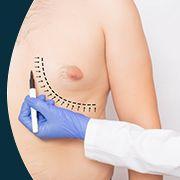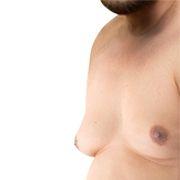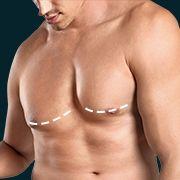Gynecomastia vs. Fat: What’s The Difference?
In This Article
Gynecomastia vs. Fat: What’s The Difference?
Pooja
Updated on February 04, 2025
Medically verified by Dr. Arya
Fact checked by Dr. Fazeela

Cosmetic
6 min read
Each of them might represent gynecomastia – the development of breast tissue to a certain extent or to a higher one – or just chest fat also known as “pseudogynecomastia.”
It is important to see the difference, especially when it comes to an individual's wellbeing, fitness and energy, as well as to self esteem and correct treatment.
Through this blog, Mykare Health will help you to understand more about gynecomastia.
Gynecomastia and Chest Obesity
Gynecomastia is a condition characterised by enlargement of the male breast tissue due to hormonal disproportion between testosterone and oestrogen.
This condition may lead to formation of a fixed hard nodule beneath the nipple area which may be tender. The hormonal changes that cause gynecomastia can happen independently at various stages including infancy, puberty and during old age.
However, the condition can develop due to reasons such as prescription drugs, corticosteroids or any other illnesses including liver or kidney diseases.
On the contrary, chest fat or pseudogynecomastia is caused by excessive deposition of fat within the chest area related to obesity or physical inactivity. The major characteristic is that chest fat lacks the dense glandular tissue the ‘real’ gynecomastia possesses.
It’s more of a loose feeling and is usually not painful or sensitive at all and, if it is tender, it’s tender all over and not just in specific locations. It remains pivotal in the case of pointing clients to the right solution that could be life changes or medication.
How to Identify the Differences: Signs and Symptoms
It is easy for patients to get misled between gynecomastia and chest fat since both produce a more breast-like appearance on the man’s chest. Here’s a breakdown to help differentiate the two
1. Texture and Feel
- Gynecomastia: Normally it presents as a firm rubbery mass felt under the nipple. It may feel tender to touch.
- Chest Fat: Tines fine, no fibrous feeling to it, and presses more flat against the chest wall.
2. Symmetry
- Gynecomastia: May arise as either unilateral or bilateral abnormally formed and/or sized mammary gland.
- Chest Fat: The distribution of the breast was beautifully symmetrical and had equal sizes on either side of the chest.
3. Pain or Sensitivity
- Gynecomastia: May lead to any form of irritation such as that of the breast skin or even pain around the nipple.
- Chest Fat: Painful lesion is usually not experienced, because glandular tissue is involved in the formation of the lesion.
4. Nipple and Areola Changes
- Gynecomastia: May give a hard look or a swollen or puffy look in the nipple and areola complex.
- Chest Fat: Does not usually change the shape and size of the nipple and the surrounding areola.
5. Physical Examination
Though the only confirmatory method is to visit a health professional for a physical exam, you can perform a home check by pinching the tissue around the chest.
If there is a firm disc-like structure under the nipple, it could be gynecomastia. If the tissue feels quite soft and is scattered over the abdominal wall, then it is chest fat.
Causes: Why Does It Happen?
Gynecomastia is virtually exclusively a matter of hormones. Although men have small traces of oestrogen levels, the hormone that causes breast tissue growth, whenever the balance of oestrogen levels increases or testosterone levels decrease, gynecomastia may occur.
The following are some common causes
- Hormonal Changes: It can be caused by things such as puberty, ageing or hormonal imbalance.
- Medications: Breast tissue development resulting from certain drugs takes place due to the use of antiandrogen, anabolic steroids and certain heart medications.
- Substance Use: Alcohol, marijuana, and other substances are also known to affect human hormones which might lead to gynecomastia.
In contrast, chest fat accumulation is usually due to
- Obesity: Research suggests that higher BMI of individuals causes fat accumulation around the chest cavity.
- Lack of Exercise: Lack of movement means muscles lose their cut appearance and the fat begins to settle.
- Poor Diet: Large food portions as well as intake of unhealthy foods such as fattening foods and sweetened products is associated with overall store energy and thus determinative of chest fat.
 9 min read
9 min readThe Advantages of Choosing Mykare Health for Gynecomastia Surgery
 6 min read
6 min readIdentifying The Ideal Age For Gynecomastia Surgery
 6 min read
6 min readPre and Post Gynecomastia Surgery: Essential Things to Know
Get a Callback Now
Diagnosis: How to Confirm?
If you perceive signs that you are suffering from gynecomastia, then you have to seek a proper diagnosis. A healthcare provider will normally recommend a clinical breast examination during which he or she will examine the texture and distribution of the breast tissue.
These cases sometimes require imaging like ultrasound or mammography for determination of glandular to fatty tissue differentiation.
Further, information may also involve biochemical assays such as blood studies for screening hormonal dysfunctions, liver profiles and thyroid profile. This way of handling things makes sure that any severe diseases, which may have led to the occurrence of gynecomastia, have to be detected at an early stage.
Treatment Options
For Gynecomastia
- Watchful Waiting: Primary gynecomastia is usually observed in puberty, in this case, the condition disappears within one or two years.
- Medications: Tamoxifen or other aromatase inhibitors have been shown to minimise breast tissue size.
Surgery: In case of focal persistent gynecomastia the first choice treatment is liposuction or mastectomy to remove excess glandular tissue.
For Chest Fat
- Diet and Exercise: It is therefore evident that practising cardiovascular exercises and incorporating strength training, besides reading the right foods and avoiding unhealthy products to reduce general obesity including chest obesity.
- Targeted Workouts: Pay much attention to pectoral muscles exercises like Bench Press, pushups, and chest flies. This approach improves the predetermined look of the chest muscles providing the chest a more muscular look.
- Weight Loss Programs: Structured weight loss program is recommended if the chest fats are associated with obesity.
Social, Mental and Emotional Consequences
Both gynecomastia and obesity of the chest area can lead to psychological disturbances in men. It becomes embarrassing to these men during swimming, doing gym among other areas where the chest area is sensitive.
Indeed, participants in the research of men with gynecomastia claimed to be less self confident and have a poor body image. These can result in rejection of social interactions and consequently a poor quality of life is experienced.
Hence, it requires you to seek help from a physician or a health care or a mental health worker, as are the feelings as important as the symptoms.
When to See a Doctor?
Whenever one experiences new breast tissue formation, pain or unequal breast size or shape it is advised to seek medical advice. There are cases where gynecomastia can be indicative of a further medical problem, for instance; hormonal imbalance, or tumour. The use of life adjustments or medications that are recommended at an early stage can improve health status.
Gynecomastia is a condition characterised by enlargement of the male breast tissue due to hormonal disproportion between testosterone and oestrogen.
Chest fat or pseudogynecomastia is caused by excessive deposition of fat within the chest area related to obesity or physical inactivity.
Gynecomastia and fat can be differentiated by analysing the following: texture, feel, symmetry, pain, sensitivity, changes around nipple or areola, and through physical examination.
Treatment for gynecomastia include medication, surgery etc and for chest fat diet, exercise, and targeted workouts are the treatment options.
Source Links
Gynecomastia vs Fat - What Do I Have?
Chest Fat Vs. Gynecomastia: How To Tell The Difference
Chest Fat and Gynecomastia



